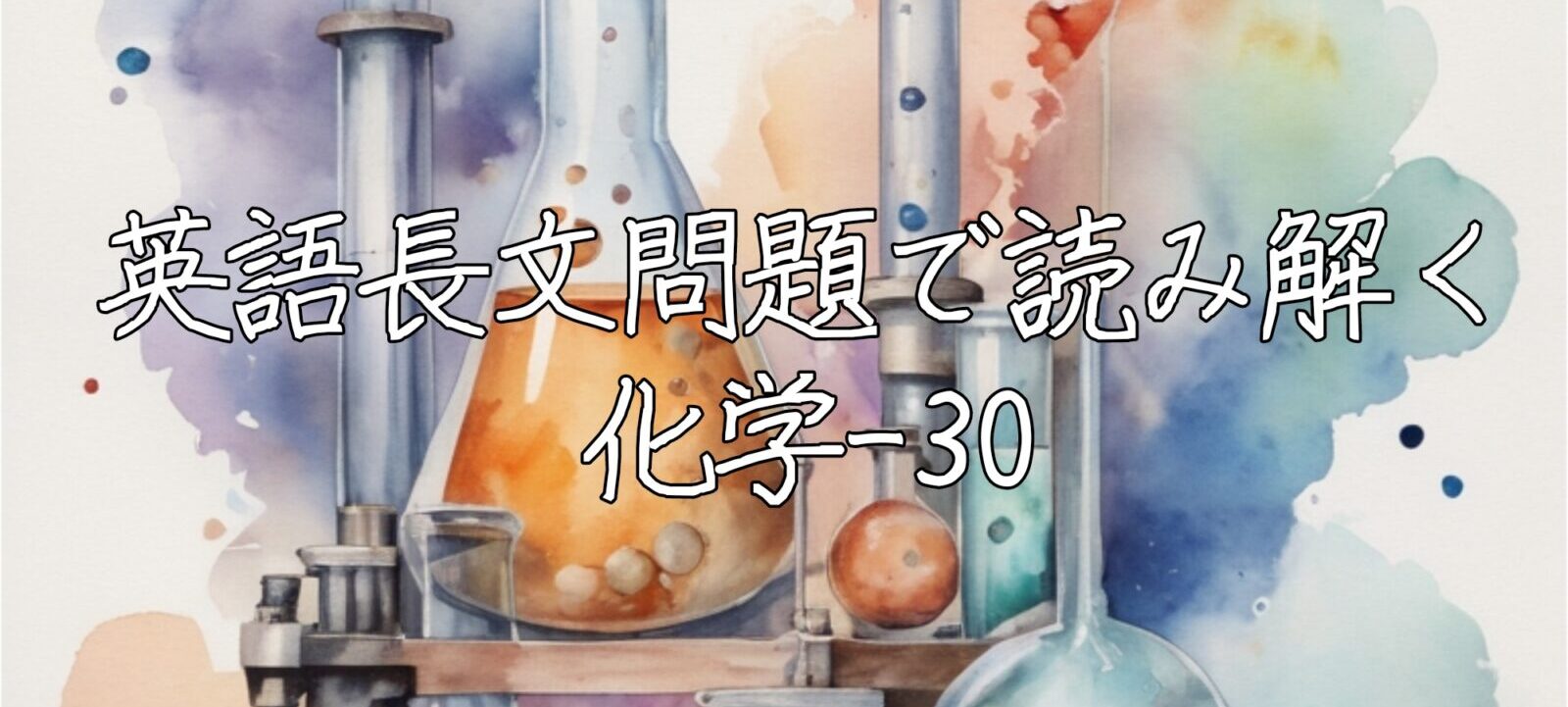英検2級レベルの英語長文問題を読み解きながら、化学の基本的な知識を身につけることが出来る問題集をkindleにて出版しました!

英語長文問題で読み解く化学-30: 化学の重要テーマを英語で読み解く 英語長文問題で読み解く学問シリーズ
英語長文で読み解く化学-30 の中身を公開!
以下、どんな内容になっているのかを公開します!
目次
はじめに
1.原子 – 物質を構成する最小単位。電子、陽子、中性子から成る。
2.分子 – 2つ以上の原子が化学結合によって結びついたもの。
3.化合物 – 2つ以上の異なる元素が化学結合してできた物質。
4.質量数 – 原子核に含まれる陽子と中性子の合計数。
5.イオン – 電子を失ったり得たりして電荷を持つ原子や分子。
6.価電子 – 原子の最外殻に存在する電子。化学結合の形成に関与する。
7.化学結合 – 原子や分子が安定した状態になるために形成する結合。
8.イオン結合 – 陽イオンと陰イオンが電気的な引力によって結びつく結合。
9.共有結合 – 2つ以上の非金属原子が価電子を共有することによって形成される結合。
10.金属結合 – 金属原子が価電子を共有することにより形成される結合。
11.酸化還元反応 – 電子の移動に伴い、酸化数が変化する化学反応。
12.酸と塩基 – 酸は陽子を供与する化合物、塩基は陽子を受け取る化合物。
13.化学平衡 – 反応物と生成物の変化率が等しくなった状態。
14.熱化学 – 化学反応と熱エネルギーの関係に関する学問領域。
15.分子構造 – 分子を構成する原子の三次元的な配置。
16.結晶 – 原子や分子が規則正しく配列した固体。
17.ポリマー – 長い鎖状に繋がった分子。多数の単体分子が結合して形成される。
18.電気化学 – 電気と化学反応の相互作用に関する学問領域。
19.有機化学 – 炭素を含む化合物の研究。
20.無機化学 – 有機化合物を除く全ての化合物の研究。
21.生物化学 – 生物の化学的過程を研究する学問。
22.物理化学 – 物質の物理的性質と化学反応の関係を研究する学問。
23.環境化学 – 環境中の化学物質とその影響を研究する学問。
24.同位体 – 原子番号は同じであるが、質量数が異なる原子。
25.キラリティ – 鏡像と重ね合わせることができない分子の性質。
26.分子動力学 – 分子の運動と相互作用をシミュレーションする方法。
27.化学反応速度 – 化学反応が進行する速さ。
28.活性化エネルギー – 化学反応が進行するために必要な最小のエネルギー。
29.エンタルピー – 系の内部エネルギーに圧力と体積の積を加えたもの。
30.吸熱反応 – 反応が進行する際に熱を吸収する反応。
1.原子 – 物質を構成する最小単位。電子、陽子、中性子から成る。
The Fascinating World of Atoms
Have you ever wondered what everything around us is made of? The answer lies in the fascinating world of atoms. Atoms are the fundamental building blocks of all matter in the universe. They are incredibly small, so small that millions of them could fit across the width of a human hair.
An atom consists of three main particles: protons, neutrons, and electrons. Protons and neutrons are found in the central part of the atom, called the nucleus. Electrons orbit around the nucleus in shells or energy levels. Protons have a positive electrical charge, while electrons have a negative charge. Neutrons, as the name suggests, are neutral, having no electrical charge.
The number of protons in an atom determines what element it is. For example, all hydrogen atoms have one proton, all carbon atoms have six protons, and all gold atoms have 79 protons. This number, known as the atomic number, is unique to each element and is a crucial identifying factor.
Atoms of the same element can have different numbers of neutrons. These variations are called isotopes. Some isotopes are stable, while others are radioactive, meaning they undergo spontaneous decay by emitting radiation. Radioactive isotopes have various applications in fields such as medicine, science, and technology.
One of the most remarkable properties of atoms is their ability to form chemical bonds with other atoms. This bonding occurs when atoms share or transfer electrons, resulting in the formation of molecules and compounds. For instance, when two hydrogen atoms bond with one oxygen atom, they form a water molecule (H2O).
The study of atoms and their behavior is crucial in understanding the world around us. It has led to groundbreaking discoveries and advancements in fields such as chemistry, physics, and biology. The discovery of the atom’s structure by scientists like Ernest Rutherford and Niels Bohr has revolutionized our understanding of matter and paved the way for modern science and technology.
Atoms are not only the building blocks of matter but also the source of energy. Nuclear fission and fusion, processes that involve the splitting or merging of atomic nuclei, respectively, are the basis of nuclear power generation. While nuclear power has its controversies, it remains an important energy source for many countries.
The world of atoms is truly fascinating, and as our understanding of these tiny particles continues to evolve, we can expect even more remarkable discoveries and applications in the future.
注釈
- Atoms (原子)
- Matter (物質)
- Universe (宇宙)
- Protons (陽子)
- Neutrons (中性子)
- Electrons (電子)
- Nucleus (原子核)
- Shells/energy levels (殻/エネルギー準位)
- Electrical charge (電荷)
- Element (元素)
- Atomic number (原子番号)
- Isotopes (同位体)
- Radioactive (放射性)
- Radiation (放射線)
- Chemical bonds (化学結合)
- Molecules (分子)
- Compounds (化合物)
- Nuclear fission (核分裂)
- Nuclear fusion (核融合)
- Nuclear power (原子力発電)
設問
- What are atoms?
a) The smallest particles that make up all matter
b) The largest particles found in the universe
c) The building blocks of energy
d) The elements that form molecules - Which of the following particles has a positive electrical charge?
a) Neutrons
b) Protons
c) Electrons
d) Molecules - What determines the element of an atom?
a) The number of neutrons
b) The number of protons
c) The number of electrons
d) The number of shells - Which of the following is NOT a part of an atom?
a) Nucleus
b) Protons
c) Neutrons
d) Compounds - What are isotopes?
a) Atoms of the same element with different numbers of protons
b) Atoms of the same element with different numbers of neutrons
c) Atoms of different elements with the same number of protons
d) Atoms of different elements with the same number of neutrons - How do atoms form molecules and compounds?
a) By sharing or transferring electrons
b) By splitting their nuclei
c) By merging their nuclei
d) By emitting radiation - Which scientist is credited with the discovery of the atom’s structure?
a) Isaac Newton
b) Albert Einstein
c) Ernest Rutherford
d) Niels Bohr - What process involves the splitting of atomic nuclei?
a) Nuclear fission
b) Nuclear fusion
c) Chemical bonding
d) Radioactive decay - According to the passage, what can we expect in the future regarding the study of atoms?
a) More remarkable discoveries and applications
b) A decrease in the importance of atoms
c) The end of nuclear power
d) A complete understanding of all atomic properties
解答・解説
- 原子とは何ですか?
a) 全ての物質を構成する最小の粒子
b) 宇宙に存在する最大の粒子
c) エネルギーの構成要素
d) 分子を形成する元素
答え:a)
原子は全ての物質を構成する最小の粒子です。 - 次のうち、正の電荷を持つ粒子はどれですか?
a) 中性子
b) 陽子
c) 電子
d) 分子
答え:b)
陽子は正の電荷を持つ粒子です。 - 原子の元素を決定するのは何ですか?
a) 中性子の数
b) 陽子の数
c) 電子の数
d) 殻の数
答え:b)
陽子の数が原子の元素を決定します。各元素には固有の陽子数があります。 - 次のうち、原子の構成要素ではないものはどれですか?
a) 原子核
b) 陽子
c) 中性子
d) 化合物
答え:d)
化合物は原子の構成要素ではありません。化合物は2種類以上の原子が結合したものです。 - 同位体とは何ですか?
a) 陽子の数が異なる同じ元素の原子
b) 中性子の数が異なる同じ元素の原子
c) 陽子の数が同じ異なる元素の原子
d) 中性子の数が同じ異なる元素の原子
答え:b)
同位体とは、同じ元素の原子で中性子の数が異なるものを指します。
と、このような感じで、30問の長文問題が一冊にまとまっております!
化学の重要テーマ、30問あります!
目次にもあるように、30個の化学にまつわる重要テーマやキーワードを使い、長文問題を作りました。
英語力を向上させたい、かつ、化学の知識を得たい人にとって、最適な長文問題集となっております。
英語レベルは英検2級を目指している人にとって丁度いい塩梅。
理系の知識が必要とされている昨今、化学にまつわる知識を英語で得ることに慣れておくことで、進学先を選ぶ際に、海外の大学すら視野に入ったり、今後、留学を目指す際のハードルも下がることでしょう。
また、タイパを重視して、化学の知識を得つつ、英語の読解力を向上させたい人は、ぜひ活用してみてください。

英語長文問題で読み解く化学-30: 化学の重要テーマを英語で読み解く 英語長文問題で読み解く学問シリーズ

-320x180.jpg)









コメント